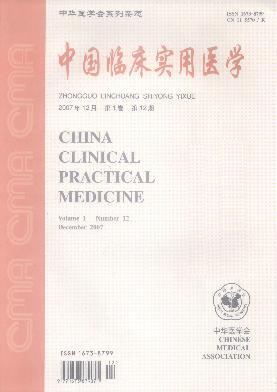Expression and clinical significance of mTOR/p70S6K signaling pathway in breast carcinoma
引用次数: 1
Abstract
Objective To investigate the expression of TOR(mammalian target of rapamycinm)/p70S6K(70 kDa ribosomal protein S6 kinase) signaling pathway in human breast carcinoma. Methods From January 2013 to January 2016, 40 cases of breast carcinom tissues,40 cases of paracancerous tissues,32 cases of normal breast tissues were selected in Binzhou Central Hospital Affiliated to Binzhou Medical College.RT-PCR and Immunohistochemistry were employed to determine the expression of mTOR/p70S6K signaling pathway in cancerous and paracancerous tissuess of 40 cases and normal healthy tissues of 32 cases. The relationship between expression of the genes mRNA in breast carcinom tissues and related parameters was analyzed. Results The expression level of mTOR was markedly higher in the breast carcinoma tissues (0.611±0.098) than in the paracancerous tissues (0.419±0.101) or normal breast tissues (0.381±0.043) .The expression of p70S6K mRNA was also higher in the breast carcinoma tissues(0.625±0.109) than in the paracancerous tissues(0.471±0.129) or normal breast tissues(0.441±0.130), with a significant difference among groups (P<0.05). There was a positive correlation between mTOR mRNA and p70S6K mRNA expressions in breast carcinom tissues (γ=0.491, P=0.019). The expression of mTOR/p70S6K signaling pathway in the breast carcinom tissues was significantly correlated with the pathological grading, lymph node metastasis, but not with the diameter, and age. Conclusions The mTOR/P70S6K signaling pathway is specifically activated in breast carcinom tissues. The mTOR/p70S6K signaling pathway might play an important role in the pathogenesis of breast carcinom. Key words: Breast carcinoma; Mammalian target of rapamycinm(mTOR); 70 kDa ribosomal protein S6 kinase(P70S6K); RT-PCR; ImmunohistochemistrymTOR/p70S6K信号通路在乳腺癌中的表达及临床意义
目的探讨TOR(哺乳动物雷帕霉素靶蛋白)/p70S6K(70 kDa核糖体蛋白S6激酶)信号通路在人乳腺癌中的表达。方法选取2013年1月至2016年1月滨州市医学院附属滨州市中心医院乳腺肿瘤组织40例、癌旁组织40例、正常乳腺组织32例。采用RT-PCR和免疫组化检测mTOR/p70S6K信号通路在40例癌组织和癌旁组织及32例正常健康组织中的表达。分析这些基因mRNA在乳腺癌组织中的表达与相关参数的关系。结果mTOR在乳腺癌组织中的表达量(0.611±0.098)明显高于癌旁组织(0.419±0.101)和正常乳腺组织(0.381±0.043),p70S6K mRNA在乳腺癌组织中的表达量(0.625±0.109)明显高于癌旁组织(0.471±0.129)和正常乳腺组织(0.441±0.130),组间差异有统计学意义(P<0.05)。乳腺癌组织中mTOR mRNA与p70S6K mRNA表达呈正相关(γ=0.491, P=0.019)。mTOR/p70S6K信号通路在乳腺癌组织中的表达与病理分级、淋巴结转移相关,与直径、年龄无关。结论mTOR/P70S6K信号通路在乳腺癌组织中被特异性激活。mTOR/p70S6K信号通路可能在乳腺癌的发病过程中发挥重要作用。关键词:乳腺癌;哺乳动物雷帕霉素靶蛋白(mTOR)的研究核糖体蛋白S6激酶(P70S6K);rt - pcr;免疫组织化学
本文章由计算机程序翻译,如有差异,请以英文原文为准。
求助全文
约1分钟内获得全文
求助全文

 求助内容:
求助内容: 应助结果提醒方式:
应助结果提醒方式:


